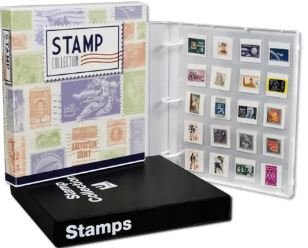For stamp collectors, ensuring that your stamps are well-preserved is essential for maintaining their value, condition, and overall appeal. How to store stamps properly might seem like a simple question, but it requires careful consideration. Proper storage can protect your stamps from physical damage, environmental factors, and deterioration, ensuring they remain in excellent condition for years to come. In this article, we’ll explore expert tips on how to store stamps properly and offer guidance on choosing the right materials, techniques, and storage environments to safeguard your collection.

Why Storing Stamps Properly Matters
Before we dive into the specifics of how to store stamps properly, let’s discuss why it’s so important. Stamps, especially rare or valuable ones, can easily suffer damage from environmental factors such as humidity, light, and temperature fluctuations. They are also susceptible to physical damage like bending, creasing, and fading. Proper storage will prevent such issues and help maintain your stamps’ integrity.
If you plan to hold onto your stamps for a long time—whether for investment or personal enjoyment—proper storage can make a significant difference in their future value. Stamps that are well-preserved tend to retain their value much better than those that are stored improperly, which can fade, tear, or become wrinkled.
How to Store Stamps Properly: Key Guidelines for Protection
1. Use Appropriate Albums and Pages
One of the most common ways to store stamps is in stamp albums. To store stamps properly, it’s important to choose the right album. Here are some tips to keep in mind when selecting an album:
- Acid-Free Materials: Always opt for albums made of acid-free paper or archival-quality materials. Acid can cause stamps to deteriorate over time, leading to discoloration and weakening of the paper. Acid-free pages prevent this damage and help keep your stamps in pristine condition.
- Lighthouse Pages or Stock Pages: Stock pages or Lighthouse pages are ideal for storing stamps. These pages are typically made of clear plastic with pockets to safely hold stamps. The plastic is non-PVC and archival-safe, ensuring that your stamps remain free from chemicals that can cause damage.
- Separate Compartments: When storing stamps in an album, always store each stamp in its own compartment to prevent them from rubbing against one another and causing damage. For large collections, consider investing in multi-ring binders to organize your stamps by country, year, or theme.

2. Avoid Direct Contact with Tape and Glue
It’s tempting to use adhesive materials like tape or glue to mount your stamps in albums or on display. However, these materials can cause permanent damage. Tape can leave sticky residues or cause stamps to tear when removed, and glue can seep into the paper, leading to discoloration and weakening over time.
If you want to attach stamps to an album or display card, use hinges or mounts made specifically for stamp storage. These are designed to hold the stamp securely without causing damage. Stamp hinges are thin, paper-like strips with a small adhesive patch that allow you to attach stamps to pages without compromising their value.
3. Store Stamps in a Controlled Environment
To store stamps properly, it’s crucial to protect them from environmental factors like humidity, temperature, and sunlight. These elements can all cause significant harm to your collection.
- Temperature Control: Stamps should be stored in a place where the temperature remains stable—ideally between 65°F and 70°F (18°C to 21°C). Extreme temperature fluctuations can cause the paper to expand and contract, potentially causing creases and bends.
- Humidity Control: Stamps are particularly sensitive to high humidity, which can cause them to become moldy or develop mildew. It’s best to store your collection in a location with a relative humidity of around 50%. Using a dehumidifier or silica gel packets can help maintain a dry, stable environment.
- Light Protection: Prolonged exposure to light, especially direct sunlight or fluorescent light, can cause stamps to fade. Always store your stamps in dark storage conditions, such as closed albums or boxes, and avoid displaying them under bright lights for extended periods.

4. Store Stamps in Protective Envelopes or Sleeves
In addition to albums and stock pages, envelopes or plastic sleeves are an excellent way to store stamps. They offer an additional layer of protection from dust, dirt, and physical damage. When choosing protective sleeves, make sure they are made from archival-safe materials that won’t interact with the stamps chemically.
- Glassine Envelopes: A popular choice for stamp collectors, glassine envelopes are transparent, acid-free, and non-static, making them an excellent option for protecting individual stamps or groups of stamps.
- Plastic Sleeves: If you prefer to store your stamps in plastic sleeves, choose ones that are PVC-free. PVC can break down over time and release harmful chemicals that can damage stamps. Opt for polypropylene or Mylar sleeves, which are safe for long-term storage.
5. Avoid Handling Stamps Without Care
While handling stamps, always take care to avoid damaging them. Here are some tips on how to store stamps properly and minimize physical damage from handling:
- Wear Gloves: Cotton gloves are a great way to protect your stamps from oils and dirt on your fingers. Even the slightest touch can leave behind fingerprints or oils that, over time, can cause degradation.
- Use Tweezers: When removing stamps from albums or protective sleeves, use tweezers designed for stamp collecting. These allow for gentle handling and minimize the risk of tearing or bending the paper.
- Never Fold Stamps: When storing or moving your collection, never fold stamps. Folded stamps can develop permanent creases, which significantly decrease their value.
6. Consider a Safe Deposit Box for Rare Stamps
For collectors with highly valuable stamps or rare editions, safe deposit boxes are an excellent option for long-term storage. These boxes provide protection from environmental elements, theft, and damage. If you’re considering this option, make sure the storage facility offers climate control and is equipped with 24-hour security.

Stamp collecting is a rewarding hobby that allows enthusiasts to connect with history, culture, and art. But to truly enjoy and preserve your collection, it’s essential to use the best stamp collecting supplies available.
7. Inventory Your Collection Regularly
To ensure that your collection is being stored properly, inventory your stamps. This can be done digitally using stamp cataloging software or a simple spreadsheet. Keep track of each stamp’s condition, location, and any protective measures you have taken.
Regularly reviewing your collection will help you identify potential issues before they become serious, such as damage to protective materials or any signs of environmental stress.
Conclusion: How to Store Stamps Properly for Long-Term Preservation
When it comes to how to store stamps properly, the key is to protect your collection from physical, environmental, and chemical damage. By following expert tips like using acid-free albums, controlling temperature and humidity, and minimizing direct handling, you can ensure that your stamps remain in excellent condition for years.
Storing your stamps in the right environment with proper materials and techniques will help preserve their value, condition, and integrity—whether you’re a passionate hobbyist or an investor looking to protect your collection for the future. Taking the time and effort to store your stamps properly is not just about preserving their appearance—it’s about ensuring they continue to tell their stories for generations.




